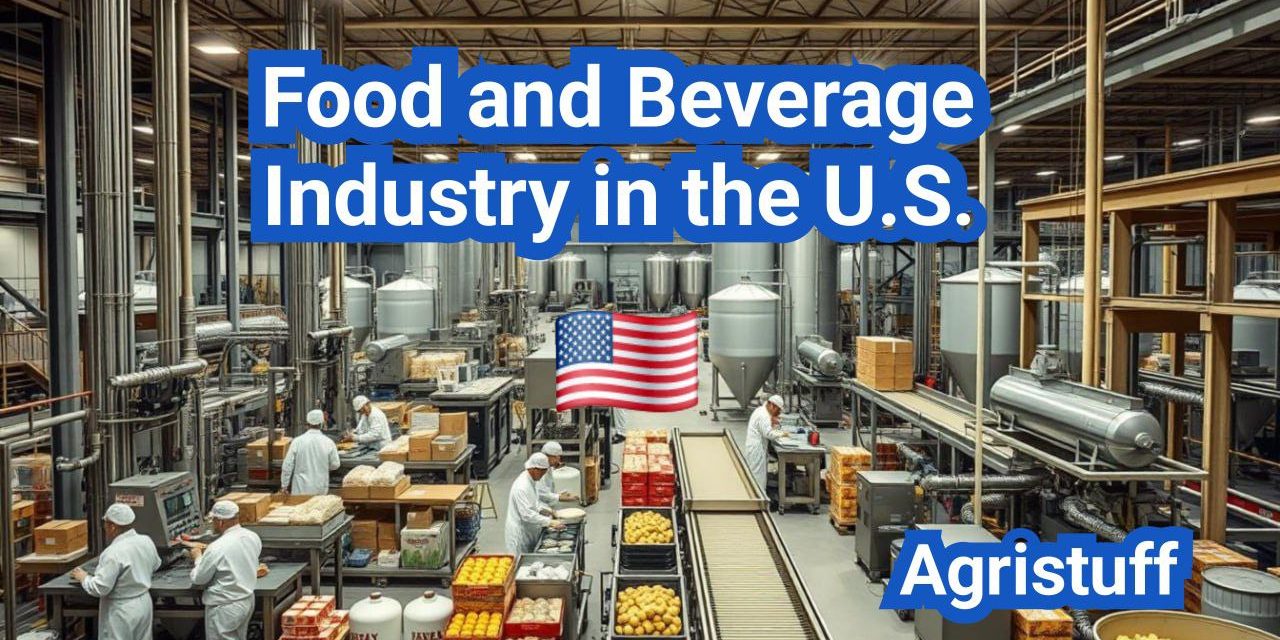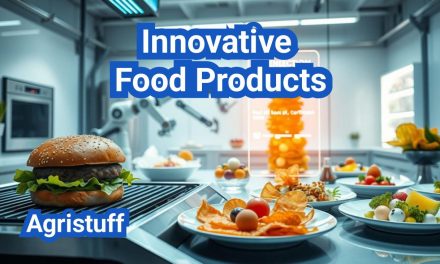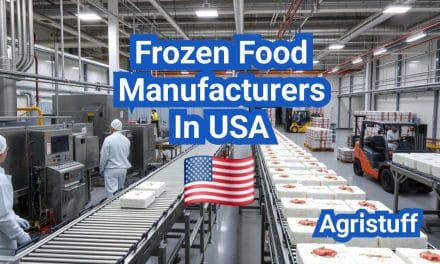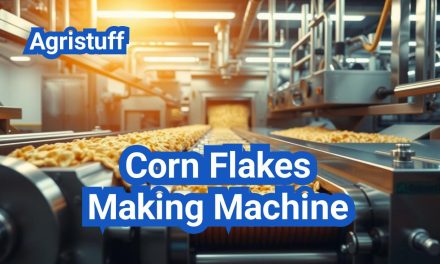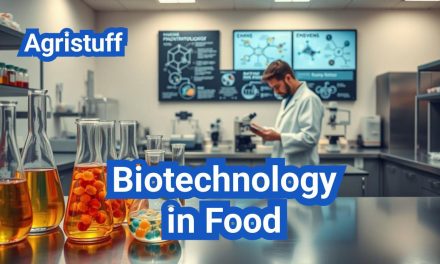The U.S. food and beverage industry is a significant sector within the global market, driven by consumer trends and technological advancements. The global market reached $7.22 trillion in 2023 and is projected to grow at a CAGR of 6.3% through 2027.
This growth is driven by changing regulatory landscapes and consumer demands. The U.S. food manufacturing sector is a crucial part of this industry, with key players driving innovation and competition.
Key Takeaways
- The global food and beverages market is projected to grow at a CAGR of 6.3% through 2027.
- The U.S. food and beverage industry is driven by consumer trends and technological advancements.
- Key players in the U.S. food manufacturing sector drive innovation and competition.
- The industry is influenced by changing regulatory landscapes.
- Consumer demands play a significant role in shaping the industry.
The Current State of the U.S. Food and Beverage Industry
The U.S. food and beverage industry is a dynamic and ever-evolving sector. As of 2024, total food sales at foodservice and food retailing outlets were approximately $2.63 trillion, underscoring the industry’s significant economic impact.
Market Size and Economic Impact
The food and beverage industry is a cornerstone of the U.S. economy. With total sales reaching $2.63 trillion in 2024, it represents a substantial portion of the country’s GDP. This economic impact is felt across various sectors, from agriculture to retail, highlighting the industry’s vast reach and influence.
Key economic indicators include:
- Employment: The industry is a major employer, providing jobs across the supply chain.
- GDP Contribution: The food and beverage sector contributes significantly to the national GDP.
- Investment: Continuous investment in technology and infrastructure drives growth.
Industry Growth Rates and Projections
The U.S. food and beverage industry is experiencing steady growth, driven by changing consumer preferences and advancements in food technology. Projections indicate continued expansion, with an expected annual growth rate of 3-4% over the next five years.
Key drivers of growth include:
- Increasing demand for convenience foods and beverages.
- Advancements in food processing and packaging technologies.
- Growing consumer interest in health and wellness products.
Regional Distribution Across the U.S.
The food and beverage industry’s regional distribution varies significantly across the U.S. States like California, New York, and Texas play major roles due to their large consumer bases and significant agricultural production.
Regional highlights:
- California leads in food and beverage manufacturing, driven by its agricultural output and innovative food companies.
- New York is a hub for food processing and distribution, serving a large and diverse consumer market.
- Texas is a significant player in both food and beverage manufacturing and distribution, benefiting from its large size and strategic location.
Understanding the Structure of the Food and Beverage Industry

The U.S. food and beverage sector is multifaceted, comprising several key segments that work together to bring products to consumers. This complex industry involves various subsectors, including harvesters, processors, distributors, and brands, all playing crucial roles in the supply chain.
Food Manufacturing Segment Analysis
The food manufacturing segment is a significant component of the industry, encompassing a wide range of activities such as meat processing, dairy processing, and snack manufacturing. These processes transform raw ingredients into consumable products, adding value and creating a diverse array of food items available to consumers.
Within this segment, companies vary in size and specialization, from large multinational corporations to smaller, niche manufacturers. The segment’s complexity is further increased by the need for compliance with food safety regulations and quality control measures.
Beverage Production Categories
Beverage production is another critical aspect of the food and beverage industry, covering categories such as soft drinks, juices, coffee, tea, and alcoholic beverages. Each category has its unique production processes, distribution networks, and consumer preferences.
The beverage sector is highly competitive, with companies continually innovating to meet changing consumer tastes and preferences. This includes the development of new flavors, packaging innovations, and the incorporation of health-conscious ingredients.
Distribution Channels and Retail Integration
Effective distribution channels are vital for getting food and beverage products to consumers. These channels include supermarkets, convenience stores, online retailers, and foodservice providers. The rise of e-commerce has significantly impacted distribution strategies, with many companies now offering direct-to-consumer sales.
Retail integration involves the strategic alignment of production, distribution, and sales efforts to ensure that products are available where and when consumers want them. This includes managing inventory levels, optimizing logistics, and implementing efficient supply chain management practices.
How to Identify Key Players in the U.S. Market
Identifying key players in the U.S. food and beverage market requires an understanding of both major manufacturers and emerging trends. The industry is characterized by a mix of large, established companies and innovative startups.
Top Food Manufacturing Companies and Their Specialties
The U.S. food manufacturing sector is dominated by companies that specialize in various product categories. Tyson Foods and Smithfield Foods are leading players in the meat processing sector, while companies like Kellogg’s and General Mills are prominent in the cereal and snack food markets.
These companies have established themselves through their commitment to quality, innovation, and customer satisfaction. Their specialties range from poultry and meat products to breakfast cereals and snack foods.
Leading Beverage Manufacturers and Market Share
The beverage market in the U.S. is highly competitive, with major players like PepsiCo and Coca-Cola holding significant market share. These companies have a long history of innovation and brand recognition, with a diverse portfolio that includes soft drinks, juices, and bottled water.
Other notable beverage manufacturers include Nestle and Dr Pepper Snapple Group, which also have a substantial presence in the market. Their success can be attributed to their ability to adapt to changing consumer preferences and trends.
Emerging Startups and Innovation Leaders
Alongside the established giants, the U.S. food and beverage industry is also home to a growing number of emerging startups. These companies are driving innovation in areas such as plant-based products, sustainable packaging, and functional beverages.
Startups like Impossible Foods and Oatly have gained significant attention for their innovative products and commitment to sustainability. These companies are not only challenging traditional industry players but also pushing the boundaries of what is possible in the food and beverage sector.
How to Achieve Regulatory Compliance in Food and Beverage Operations

Achieving regulatory compliance is crucial for food and beverage businesses operating in the U.S. market. Regulatory compliance involves adhering to various food safety regulations and standards, including the Food Safety Modernization Act (FSMA), Hazard Analysis and Critical Control Points (HACCP), and Global Food Safety Initiative (GFSI) certification.
Step-by-Step FSMA Compliance Implementation
To achieve FSMA compliance, food and beverage companies must implement a series of preventive controls. This involves:
- Conducting a hazard analysis to identify potential risks
- Implementing preventive controls to mitigate identified hazards
- Establishing procedures for monitoring and verifying the effectiveness of these controls
- Maintaining detailed records of these processes
Companies must also ensure that their supply chain partners are FSMA compliant, as the regulation emphasizes a preventive approach to food safety.
Developing and Maintaining HACCP Plans
HACCP plans are critical for identifying and controlling hazards in the food production process. To develop a HACCP plan:
- Conduct a thorough hazard analysis
- Identify critical control points (CCPs)
- Establish critical limits for each CCP
- Implement monitoring procedures
- Develop corrective actions for when a CCP is not within the established limits
Regular review and update of HACCP plans are necessary to ensure ongoing effectiveness and compliance.
Obtaining GFSI Certification
GFSI certification is recognized globally and demonstrates a company’s commitment to food safety. To obtain GFSI certification, businesses must:
- Choose a GFSI-benchmarked certification scheme
- Implement the required food safety management system
- Undergo a pre-audit and subsequent certification audit by an accredited certification body
Maintaining GFSI certification requires ongoing compliance with the chosen scheme’s requirements and regular audits.
By following these steps and maintaining a commitment to regulatory compliance, food and beverage companies can ensure the safety and quality of their products, protect consumers, and maintain a competitive edge in the market.
Navigating Food Labeling Requirements in the U.S.
Navigating the complex landscape of food labeling requirements is essential for U.S. food manufacturers. The FDA sets strict guidelines for what information must be included on food labels to ensure consumer safety and informed decision-making.
Implementing FDA Labeling Regulations
The FDA requires food labels to include specific information, such as nutrition facts panels and ingredient lists. Compliance with these regulations is crucial to avoid legal issues and maintain consumer trust.
Key components of FDA labeling regulations include accurate nutrition facts, proper ingredient listing, and clear allergen declarations. Manufacturers must ensure that their labeling practices are compliant with the latest FDA guidelines.
Creating Compliant Nutrition Facts Panels
Nutrition facts panels are a critical component of food labeling. They must be accurate and comply with FDA formatting requirements. This includes listing serving sizes, calories, and percentages of daily values for various nutrients.
Best practices for nutrition facts panels involve regularly updating nutrient databases to reflect the latest scientific research and FDA guidelines. Manufacturers should also ensure that their serving sizes are realistic and based on actual consumption patterns.
Managing Allergen Declarations and Marketing Claims
Allergen declarations are vital for consumer safety, particularly for individuals with life-threatening allergies. The FDA requires the declaration of major food allergens, such as peanuts, tree nuts, milk, eggs, fish, shellfish, wheat, and soybeans.
Marketing claims on food labels must be substantiated by scientific evidence. Claims related to health benefits, nutrient content, or environmental impact must comply with FDA regulations to avoid being considered misleading.
By understanding and implementing these labeling requirements, food manufacturers can ensure compliance with FDA regulations, enhance consumer trust, and maintain a competitive edge in the U.S. market.
How to Optimize Your Food Supply Chain

Effective supply chain management is the backbone of the food industry, ensuring products reach consumers safely. Optimizing the food supply chain involves several key strategies that can improve efficiency, reduce costs, and enhance food safety.
Mapping and Analyzing Supply Chain Components
Mapping the supply chain is the first step towards optimization. It involves identifying all the components, from sourcing raw materials to delivering the final product to consumers. Supply chain mapping helps in understanding the flow of goods, services, and information.
Analyzing these components is crucial for identifying bottlenecks and areas of improvement. Techniques such as value stream mapping can help in visualizing the supply chain and pinpointing inefficiencies.
Implementing Effective Cold Chain Management
Cold chain management is critical for perishable goods, ensuring that products remain at the right temperature throughout the supply chain. Effective cold chain management involves using refrigerated transportation, storage facilities, and monitoring systems to maintain the required temperature.
Implementing cold chain management solutions can significantly reduce spoilage and extend the shelf life of products. Technologies such as IoT sensors play a vital role in monitoring temperature and humidity levels in real-time.
| Cold Chain Management Strategies | Benefits |
|---|---|
| Refrigerated Transportation | Maintains product temperature during transit |
| Advanced Monitoring Systems | Real-time tracking of temperature and humidity |
| Strategic Storage Facilities | Ensures products are stored at optimal conditions |
Leveraging Technology for Supply Chain Visibility
Supply chain visibility is essential for making informed decisions and responding to disruptions. Technologies such as blockchain, IoT, and data analytics provide real-time insights into the supply chain.
By leveraging these technologies, companies can track products throughout the supply chain, predict potential disruptions, and optimize logistics. This not only improves efficiency but also enhances food safety by enabling quick responses to contamination or quality issues.
- Blockchain for traceability
- IoT for real-time monitoring
- Data analytics for predictive insights
Optimizing the food supply chain is a multifaceted process that involves mapping and analyzing supply chain components, implementing effective cold chain management, and leveraging technology for greater visibility. By adopting these strategies, food companies can improve efficiency, reduce costs, and enhance food safety.
Setting Up Food Processing and Manufacturing Operations

Setting up a successful food processing operation involves several key considerations, including technology selection and quality control. The efficiency and effectiveness of these operations are crucial to the overall success of the food and beverage industry.
Selecting Appropriate Processing Technologies
The selection of appropriate processing technologies is vital for ensuring the quality and safety of food products. Advances in food processing technologies, such as high-pressure processing and aseptic processing, have significantly improved product safety and quality. High-pressure processing, for instance, allows for the preservation of food without the need for heat, thereby retaining more nutrients.
When choosing processing technologies, manufacturers must consider factors such as the type of product being processed, production volume, and regulatory requirements. A thorough analysis of these factors will help in selecting the most appropriate technology.
“The right processing technology can make a significant difference in the quality and safety of the final product.”
Implementing Quality Control Systems
Implementing robust quality control systems is essential for maintaining high standards in food processing and manufacturing. These systems help in identifying and mitigating potential risks throughout the production process.
- Regular monitoring and testing of products and production environments
- Implementation of HACCP (Hazard Analysis and Critical Control Points) plans
- Training of personnel on quality control procedures
Effective quality control systems not only ensure compliance with regulatory requirements but also enhance consumer trust and loyalty.
| Quality Control Measure | Description | Benefits |
|---|---|---|
| Regular Monitoring | Ongoing inspection of production processes and products | Early detection of potential issues |
| HACCP Plans | Systematic approach to identifying and controlling hazards | Enhanced food safety |
| Personnel Training | Education of staff on quality control procedures | Consistent application of quality standards |
Integrating Automation in Production Lines
Integrating automation into production lines can significantly enhance efficiency, consistency, and scalability in food processing and manufacturing. Automated systems can perform tasks such as packaging, sorting, and inspection with high precision and speed.
When integrating automation, manufacturers should consider factors such as the initial investment, maintenance requirements, and the potential for future upgrades. It’s also crucial to ensure that automated systems are compatible with existing production processes.
By carefully selecting processing technologies, implementing robust quality control systems, and integrating automation, food manufacturers can establish efficient and effective operations that meet consumer demands and regulatory requirements.
Guide to Specialized Manufacturing Segments

The U.S. food industry is comprised of various specialized manufacturing segments, including meat processing, dairy processing, and frozen foods. These segments require specific knowledge, equipment, and compliance with regulations.
Establishing Meat Processing Operations
Meat processing is a significant segment, with companies like Tyson Foods and JBS USA playing major roles. To establish a meat processing operation, one must consider factors such as facility design, equipment selection, and regulatory compliance.
- Facility design and layout
- Equipment selection and maintenance
- Regulatory compliance and food safety
Setting Up Dairy Processing Facilities
Dairy processing involves the production of milk, cheese, and other dairy products. Setting up a dairy processing facility requires careful planning, including the selection of processing technologies and implementation of quality control measures.
- Selecting appropriate processing technologies
- Implementing quality control systems
- Ensuring regulatory compliance
Entering the Frozen Food Market
The frozen food market is another significant segment, with a wide range of products including frozen vegetables, meats, and prepared meals. To enter this market, companies must consider factors such as product development, packaging, and distribution.
By understanding the unique challenges and opportunities in each of these specialized manufacturing segments, companies can better navigate the complexities of the U.S. food industry.
Developing Effective Food Packaging Strategies

Food packaging is not just about containment; it’s about communication and sustainability. In today’s competitive market, effective packaging can be a significant differentiator for food products.
As consumers increasingly demand more sustainable packaging options, companies must balance the need for protection, preservation, and presentation with environmental concerns. “Sustainability is no longer a niche but a mainstream expectation,” as noted by a leading industry expert
“The future of packaging lies in its ability to be both functional and environmentally friendly.”
Selecting Packaging Materials and Technologies
The choice of packaging materials and technologies is critical in ensuring product safety and quality. Companies must consider factors such as barrier properties, durability, and cost when selecting packaging materials.
Key considerations include:
- Barrier properties to prevent moisture, oxygen, and light exposure
- Durability to withstand transportation and storage
- Cost-effectiveness without compromising on quality
Advanced technologies, such as modified atmosphere packaging (MAP) and active packaging, can enhance product shelf life and quality.
Implementing Sustainable Packaging Solutions
Sustainability is becoming a key driver in packaging decisions. Companies are exploring eco-friendly materials, such as bioplastics, recycled materials, and biodegradable packaging.
Strategies for sustainable packaging include:
- Reducing packaging material usage
- Using recyclable or biodegradable materials
- Designing for recyclability and reusability
By adopting sustainable packaging practices, companies can reduce their environmental footprint and appeal to eco-conscious consumers.
Meeting Packaging Regulations and Standards
Compliance with packaging regulations and standards is crucial to avoid legal issues and ensure consumer trust. Companies must stay informed about changing regulations, such as those related to food contact materials and labeling.
Key regulatory considerations include:
| Regulation | Description | Impact |
|---|---|---|
| Food Contact Materials | Regulations governing materials that come into contact with food | Ensures safety and compliance |
| Labeling Requirements | Regulations regarding labeling, including nutrition facts and allergen warnings | Ensures transparency and consumer safety |
By understanding and adhering to these regulations, companies can ensure their packaging meets legal standards and consumer expectations.
How to Succeed in Private Label Manufacturing
To thrive in private label manufacturing, companies need to identify opportunities, develop competitive products, and build strong retailer partnerships. This involves understanding consumer trends, retailer needs, and market dynamics.
Identifying Private Label Opportunities
Private label products are becoming increasingly popular, with retailers like Walmart and Target offering their own branded products. To identify opportunities, manufacturers should analyze consumer trends and retailer needs.
- Analyze consumer demand for private label products in various categories.
- Assess retailer requirements for product quality, pricing, and packaging.
- Identify gaps in the market that can be filled with innovative private label products.
Market research is crucial in identifying private label opportunities. Manufacturers should stay up-to-date with the latest consumer trends and preferences.
Developing Competitive Private Label Products
Developing competitive private label products requires a deep understanding of consumer preferences and retailer requirements. Manufacturers should focus on creating high-quality products that meet or exceed retailer standards.
| Product Attribute | Consumer Preference | Retailer Requirement |
|---|---|---|
| Quality | High-quality products | Meets or exceeds standards |
| Pricing | Competitive pricing | Margins that support retailer business model |
| Packaging | Attractive and functional packaging | Compliant with retailer packaging standards |
Innovative packaging can be a key differentiator for private label products. Manufacturers should consider using sustainable materials and designs that appeal to consumers.
Building Retailer Partnerships and Contracts
Building strong partnerships with retailers is critical to success in private label manufacturing. Manufacturers should focus on developing collaborative relationships that benefit both parties.
- Develop a deep understanding of retailer business models and goals.
- Create mutually beneficial agreements that support retailer objectives.
- Foster open communication and collaboration to ensure successful partnerships.
Contract negotiation is a critical aspect of building retailer partnerships. Manufacturers should ensure that contracts are fair, flexible, and aligned with retailer needs.
Effective Food and Beverage Management Practices

The food and beverage industry relies heavily on effective management to maintain quality, safety, and customer satisfaction. Effective food and beverage management involves a range of practices, from leadership and team building to operations management. Directors and managers must balance the need for quality, safety, and customer satisfaction with operational efficiency and cost control.
Key Responsibilities of Food and Beverage Directors
Food and beverage directors play a crucial role in the success of their organizations. Their key responsibilities include overseeing daily operations, managing budgets, and ensuring compliance with health and safety regulations. They must also lead their teams effectively, fostering a culture of excellence and continuous improvement.
Some of the specific tasks that food and beverage directors are responsible for include:
- Developing and implementing operational strategies
- Managing inventory and supply chain logistics
- Overseeing food preparation and presentation
- Ensuring customer satisfaction through quality service
Implementing Operations Management Best Practices
Effective operations management is critical in the food and beverage industry. This involves streamlining processes, reducing waste, and improving efficiency. Best practices include implementing robust inventory management systems, optimizing menu or product offerings, and leveraging technology to enhance operational efficiency.
Some key strategies for improving operations management include:
- Conducting regular audits to identify areas for improvement
- Implementing lean manufacturing principles to reduce waste
- Investing in staff training to enhance productivity
Building and Leading Effective Teams
Building and leading effective teams is essential for success in the food and beverage industry. This involves recruiting the right talent, providing ongoing training and development opportunities, and fostering a positive work environment. Effective team leaders must also be able to motivate their teams, manage conflicts, and drive performance.
Some strategies for building effective teams include:
- Developing clear job descriptions and performance expectations
- Providing regular feedback and coaching
- Fostering a culture of teamwork and collaboration
By focusing on these key areas, food and beverage organizations can improve their management practices, drive operational efficiency, and enhance customer satisfaction.
When and How to Use Consulting Services

As the food and beverage landscape continues to shift, companies are turning to consulting services to navigate challenges and capitalize on opportunities. The industry’s complexity, from regulatory compliance to supply chain optimization, necessitates expert guidance to stay competitive.
Types of Food and Beverage Consultants to Consider
Food and beverage companies can benefit from various types of consultants, each specializing in different areas:
- Regulatory Compliance Consultants: Experts who help navigate FDA regulations, FSMA compliance, and other legal requirements.
- Operational Efficiency Consultants: Professionals who analyze and improve production processes, supply chain management, and distribution networks.
- Strategic Planning Consultants: Advisors who assist in developing business strategies, market analysis, and competitive positioning.
- Sustainability and Quality Consultants: Specialists who implement sustainable practices, quality control systems, and food safety protocols.
Determining When External Expertise is Needed
Companies must assess their needs to determine when to seek external expertise. Key indicators include:
- Increasing operational costs without corresponding productivity gains.
- Regulatory non-compliance issues or pending audits.
- Stagnant growth or declining market share.
- Complex project requirements that exceed in-house capabilities.
By recognizing these signs, businesses can proactively seek consulting services to address their specific challenges.
Maximizing Return on Consulting Investments
To ensure a strong return on investment, companies should:
- Clearly define project objectives and expected outcomes.
- Select consultants with proven experience in the food and beverage industry.
- Establish a robust communication plan to ensure seamless collaboration.
- Monitor progress and adjust strategies as needed.
By following these guidelines, food and beverage companies can effectively leverage consulting services to drive growth, improve operations, and enhance their competitive edge.
Developing Marketing Strategies for Food and Beverage Products
Effective marketing in the food and beverage industry hinges on creating compelling brand stories and engaging consumers across multiple channels. To achieve this, companies must understand their target audience, stay ahead of trends, and leverage various marketing tools to drive sales and brand awareness.
Creating Compelling Brand Positioning
Brand positioning is about differentiating your product in the minds of consumers. For food and beverage companies, this involves highlighting unique selling points such as organic ingredients, sustainable practices, or artisanal production methods.
Key elements of compelling brand positioning include:
- Identifying your target audience and understanding their preferences
- Developing a unique value proposition that resonates with consumers
- Consistently communicating your brand message across all marketing channels
Implementing Digital Marketing Campaigns
Digital marketing has become increasingly important in the food and beverage industry, with companies using social media, email marketing, and influencer partnerships to reach consumers.
| Digital Marketing Channel | Benefits | Challenges |
|---|---|---|
| Social Media | High engagement, targeted advertising | Content saturation, algorithm changes |
| Email Marketing | Direct communication, cost-effective | Spam filters, list maintenance |
| Influencer Partnerships | Credibility, expanded reach | Finding the right influencers, ROI measurement |
Engaging Consumers Through Multiple Channels
Engaging consumers effectively requires a multi-channel approach, incorporating both digital and traditional marketing strategies. This can include in-store promotions, events, and sampling, alongside online campaigns.
By diversifying marketing efforts, food and beverage companies can build stronger connections with their audience and drive brand loyalty.
How to Grow Your Food and Beverage Business
In the dynamic food and beverage sector, growth is often achieved through a combination of strategic mergers, innovative funding, and well-planned expansions. Companies looking to expand their operations must consider their financial situation, market opportunities, and competitive landscape.
Evaluating Merger and Acquisition Opportunities
One effective way to grow a food and beverage business is through mergers and acquisitions. This strategy allows companies to expand their product offerings, increase market share, and improve operational efficiency.
- Identify potential targets with complementary products or services.
- Conduct thorough due diligence to assess the target company’s financial health and market position.
- Negotiate terms that align with your business goals and growth strategy.
Securing Capital Through Various Funding Sources
Securing the necessary capital is crucial for growth. Food and beverage businesses can explore various funding sources, including:
- Venture capital investments.
- Private equity funding.
- Bank loans and lines of credit.
- Crowdfunding and community-supported initiatives.
Each funding source has its advantages and disadvantages, and businesses must choose the option that best aligns with their growth plans.
Developing Strategic Expansion Plans
A well-planned expansion strategy is essential for successful growth. This involves:
- Conducting market research to identify new opportunities.
- Developing a robust business plan that outlines growth objectives and strategies.
- Investing in the necessary infrastructure and talent to support expansion.
By carefully evaluating merger and acquisition opportunities, securing appropriate funding, and developing strategic expansion plans, food and beverage businesses can achieve sustainable growth and remain competitive in the market.
Preparing for Future Trends in the Food and Beverage Industry
The food and beverage industry is on the cusp of a revolution, driven by emerging technologies, evolving consumer tastes, and a growing focus on sustainability. As companies navigate this changing landscape, they must be prepared to adapt and innovate to remain competitive.
Adopting Emerging Technologies
Emerging technologies such as blockchain, artificial intelligence (AI), and the Internet of Things (IoT) are transforming the food and beverage industry. Blockchain technology, for instance, is being used to enhance supply chain transparency and traceability, while AI-powered analytics are helping companies predict consumer trends and optimize production.
- Implementing blockchain for supply chain transparency
- Utilizing AI for predictive analytics and consumer trend forecasting
- Leveraging IoT for real-time monitoring and quality control
Responding to Changing Consumer Preferences
Consumer preferences in the food and beverage industry are shifting towards healthier, more sustainable, and ethically sourced products. Companies must be responsive to these changes by innovating their product lines and marketing strategies. Plant-based alternatives and reduced sugar products are examples of how companies are adapting to consumer demands.
- Developing plant-based and vegan product lines
- Reducing sugar content and using natural sweeteners
- Implementing eco-friendly packaging solutions
Implementing Sustainability Initiatives
Sustainability is becoming a critical factor in the food and beverage industry, driven by consumer awareness and regulatory pressures. Companies are implementing various sustainability initiatives, such as reducing water usage, minimizing food waste, and adopting renewable energy sources.
- Conducting sustainability audits to identify areas for improvement
- Implementing energy-efficient equipment and practices
- Developing take-back programs for packaging materials
At The End of: Food and Beverage Industry in the U.S.
The U.S. food and beverage industry is a complex and dynamic sector, influenced by various factors including consumer trends, technological advancements, and regulatory landscapes. As discussed in the previous sections, understanding the industry’s size, structure, and key players is crucial for success.
Looking ahead, the industry is expected to continue growing, driven by consumer trends and technological advancements. Companies that adapt to changing consumer preferences, adopt emerging technologies, and prioritize sustainability will be well-positioned for success. This industry summary highlights the importance of staying informed about future outlook and trends.
As the food and beverage industry continues to evolve, businesses must remain agile and responsive to changing market conditions. By doing so, they can capitalize on emerging opportunities and navigate the challenges that lie ahead, ultimately driving growth and success in the industry.
FAQ
What is the size of the U.S. food and beverage industry?
The U.S. food and beverage industry is a significant sector, with total food sales reaching $2.63 trillion in 2024.
What are the key segments within the food and beverage industry?
The industry includes various segments such as food manufacturing, beverage production, and distribution channels, with categories ranging from meat processing and dairy processing to snack manufacturing and soft drinks.
How do companies achieve regulatory compliance in the food and beverage industry?
Companies achieve compliance by implementing preventive controls, conducting regular audits, and maintaining detailed records, as well as staying up-to-date with changing regulations such as FSMA, HACCP, and GFSI certification.
What are the key considerations for food labeling in the U.S.?
Companies must comply with FDA labeling regulations, accurately calculating nutrition facts, declaring allergens, and substantiating marketing claims to ensure compliance.
How can companies optimize their food supply chain?
Companies can optimize their supply chain by mapping and analyzing supply chain components, implementing effective cold chain management, and leveraging technology for greater visibility.
What are the key strategies for setting up food processing and manufacturing operations?
Companies should select the right processing technologies, implement robust quality control systems, and integrate automation to improve efficiency and consistency.
How can companies succeed in private label manufacturing?
Companies can succeed by identifying opportunities, developing competitive products, and building strong partnerships with retailers, while understanding consumer trends and market dynamics.
What are the key practices for effective food and beverage management?
Effective management involves leadership, team building, and operations management, balancing quality, safety, and customer satisfaction with operational efficiency and cost control.
When should companies consider using consulting services in the food and beverage industry?
Companies should consider consulting services when they need expertise to improve operations, comply with regulations, or develop strategic plans, and when they want to maximize their return on investment.
How can companies develop effective marketing strategies for food and beverage products?
Companies can develop effective marketing strategies by creating compelling brand positioning, implementing digital marketing campaigns, and engaging consumers through multiple channels, while understanding their target audience and staying ahead of trends.
What are the key considerations for growing a food and beverage business?
Companies should evaluate merger and acquisition opportunities, secure capital through various funding sources, and develop strategic expansion plans, considering their financial situation, market opportunities, and competitive landscape.
How can companies prepare for future trends in the food and beverage industry?
Companies can prepare by adopting emerging technologies, responding to changing consumer preferences, and implementing sustainability initiatives, staying ahead of trends to drive success.
Conclusion of: Food and Beverage Industry in the U.S.
Introduction
The food and beverage industry in the U.S. is one of the economy’s largest employers and a daily touchpoint for every household, spanning farms, factories, logistics hubs, retailers, and restaurants; understanding its size, structure, and key players helps entrepreneurs, job seekers, and policymakers make smarter decisions in a market that never sleeps. Bureau of Economic Analysis – Industry Data
What the Food and Beverage Industry Covers
At its core, the food and beverage industry includes the processing and manufacturing of meat, dairy, bakery, snacks, confectionery, beverages, frozen foods, and more, with supply chains that connect U.S. producers to both domestic and export markets under standardized industry classifications. U.S. Census – NAICS 311 (Food Manufacturing)
Industry Size and Economic Footprint
Because the food and beverage industry supplies essential goods at scale, its output contributes significantly to GDP and state economies, with thousands of plants and billions in annual shipments supporting rural and urban communities alike. U.S. Census – Annual Survey of Manufactures
How the Value Chain Works
The food and beverage industry value chain moves from agricultural inputs to processing, packaging, warehousing, transportation, and finally retail or foodservice, with each stage adding value while managing safety, quality, and cost. USDA ERS – Food Dollar Series
Manufacturing Segments and Codes
Within the food and beverage industry, manufacturers fall into distinct NAICS segments such as meat (3116), dairy (3115), bakeries (3118), snack and confectionery (3113), and beverages (3121), each with specialized equipment, regulations, and workforce skills. U.S. Census – NAICS Search
Retail vs. Foodservice Channels
Channel mix defines the food and beverage industry; prepared products reach consumers through grocery and mass retail (“food at home”) and through restaurants, quick-service chains, and institutions (“food away from home”), with spending patterns shifting over time. USDA ERS – Food Expenditure Series
Top-Line Demand Drivers
Consumer income, demographics, pricing, and health trends shape the food and beverage industry, influencing portfolio mix (e.g., high-protein, low-sugar, organic, and convenient formats) as producers adapt to evolving preferences. BLS – Consumer Price Index (Food)
Key Players and Competitive Landscape
Major companies anchor the food and beverage industry, including diversified CPG leaders, meat processors, dairy producers, and beverage giants that invest in R&D, marketing, automation, and distribution to defend share and expand margins. Food Processing – Top 100 Food & Beverage Companies
Meat and Poultry Processing
As a heavyweight within the food and beverage industry, meat and poultry processing operates under rigorous inspection, sanitation, and HACCP systems to ensure safety while running high-throughput lines. USDA FSIS – Food Safety
Dairy Processing and Products
Milk, cheese, and cultured products are pillars of the food and beverage industry, where pasteurization, separation, standardization, and cold-chain discipline maintain quality from farm to shelf. IDFA – Dairy Industry Resources
Bakery, Snacks, and Confectionery
From sliced bread to extruded snacks and chocolate, the food and beverage industry relies on precise mixing, proofing, thermal profiles, and ingredient functionality to achieve consistent texture and taste at scale. SNAC International – Snack Industry Association
Beverage Manufacturing
Carbonated soft drinks, bottled water, juices, coffee, tea, and functional beverages highlight how the food and beverage industry balances formulation, filtration, carbonation, filling, and packaging to satisfy diverse consumption occasions. BevNET – Beverage Industry Coverage
Frozen Foods and the Cold Chain
Frozen entrées, produce, seafood, and pizzas demonstrate how the food and beverage industry uses IQF, cryogenic, and mechanical freezing technologies alongside temperature mapping to lock in freshness and manage shelf life. AFFI – American Frozen Food Institute
Regulatory Oversight: FDA and USDA
Two federal agencies frame compliance in the food and beverage industry: FDA oversees most foods and beverages and sets preventive controls under FSMA, while USDA supervises meat, poultry, and certain egg products with continuous inspection. FDA – FSMA
Food Safety Systems and Standards
To protect consumers and brands, the food and beverage industry implements HACCP, supplier programs, environmental monitoring, allergen control, and often pursues GFSI-recognized certifications such as SQF, BRCGS, and FSSC 22000. GFSI – Recognition & Certification
Labeling, Claims, and Nutrition Facts
Clear labels help the food and beverage industry communicate ingredients, allergens, nutrition, and claims (e.g., organic, non-GMO), all of which must follow federal rules to prevent misbranding and protect consumers. FDA – Food Labeling & Nutrition
Workforce, Wages, and Safety
People power the food and beverage industry: skilled operators, quality technicians, maintenance staff, and logisticians keep lines running, while OSHA and state rules guide safety practices across facilities. BLS – Occupational Employment & Wage Statistics
Trade, Imports, and Exports
With global supply lines, the food and beverage industry depends on reliable trade relationships for ingredients and market access, supported by data, promotion, and compliance programs. USDA FAS – Trade Data
Logistics and Sanitary Transportation
Efficient distribution keeps the food and beverage industry competitive, with carriers and shippers following sanitary transport rules, temperature controls, and documentation to prevent contamination. FDA – Sanitary Transportation Rule
Packaging, Materials, and Design
Whether rigid or flexible, packaging in the food and beverage industry must protect product integrity, meet barrier requirements, and balance sustainability with cost, machinability, and consumer appeal. EPA – Sustainable Management of Food
Quality, Testing, and Shelf Life
Microbiological, chemical, and physical tests enable the food and beverage industry to validate shelf life, verify sanitation, and ensure specifications across ingredients, in-process materials, and finished goods. FDA – Laboratory Methods
Technology, Automation, and Smart Factories
From sensors and SCADA to robotics and AI, the food and beverage industry is modernizing with digital twins, predictive maintenance, and automated inspection to improve OEE and reduce waste. NIST – Smart Manufacturing
Private Label and Co-Manufacturing
Store brands and co-packing give the food and beverage industry flexibility, letting retailers launch differentiated SKUs while manufacturers fill capacity and diversify revenue streams. PLMA – Private Label Industry
E-Commerce and Omnichannel
Online grocery and direct-to-consumer models are reshaping the food and beverage industry, pushing companies to optimize last-mile logistics, assortment, and digital merchandising in tandem with brick-and-mortar. USDA ERS – Retail Trends
Innovation and R&D
Novel ingredients, clean-label formulations, and functional claims show how the food and beverage industry invests in R&D to meet health and convenience expectations without sacrificing taste or safety. IFIC – Food & Nutrition Insights
Sustainability and ESG
Across the food and beverage industry, companies track greenhouse gases, water, waste, and sourcing, working with farmers, suppliers, and NGOs to advance measurable ESG goals. EPA – Climate Change
Small and Mid-Size Manufacturers
Smaller firms in the food and beverage industry can leverage state manufacturing extensions, accelerators, and university pilot plants to validate processes, gain certifications, and access new markets. NIST MEP – Manufacturing Extension Partnership
Financing, Grants, and Incentives
Capital is vital in the food and beverage industry for equipment, facilities, and working capital, where public financing, loan guarantees, and tax incentives can improve project feasibility. USDA Rural Development – Programs
Risk Management and Recalls
Because the food and beverage industry operates under intense scrutiny, recall preparedness, traceability, and crisis communications are essential to protect consumers and brand equity. FDA – Recalls
Outlook: What to Watch
The food and beverage industry will keep navigating commodity volatility, changing taste profiles, label transparency, and technology adoption, rewarding companies that execute with agility and data-driven discipline. BEA – U.S. Economic Data
Final thought
In short, the food and beverage industry is foundational to American life and commerce; leaders that invest in safety, quality, automation, and consumer insight will outperform as demand evolves across channels and categories. USDA ERS – Economic Research
Sources & References
- Food and Beverage Industry In the U.S.: Everything You Need to Know
- Bureau of Economic Analysis – Industry Accounts
- U.S. Census – NAICS
- U.S. Census – Annual Survey of Manufactures
- USDA Economic Research Service
- U.S. Food & Drug Administration – Food
- USDA FSIS – Food Safety & Inspection Service
- Bureau of Labor Statistics
- American Frozen Food Institute
- SNAC International
- International Dairy Foods Association
- Global Food Safety Initiative
- Private Label Manufacturers Association
- NIST MEP – Manufacturing Extension
- USDA Foreign Agricultural Service
- U.S. Environmental Protection Agency

